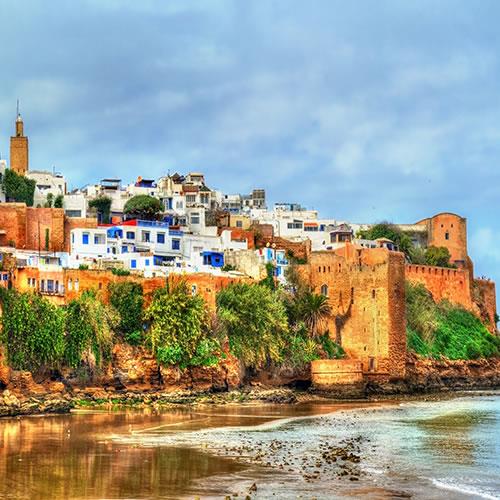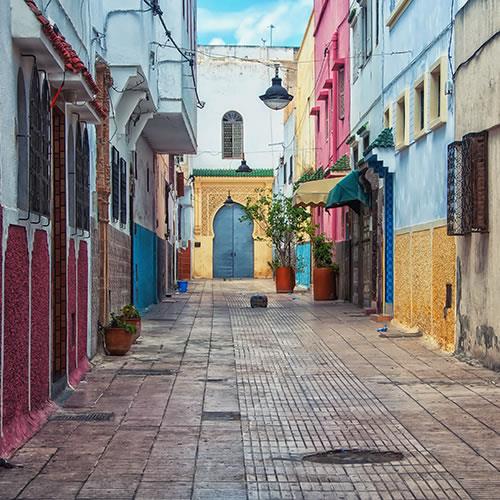EXPERIENCE RABAT


Overview
Rabat, the capital city of Morocco, elegantly combines historical depth with modernity. Situated along the Atlantic Coast, Rabat is both a political and administrative hub, exuding a polished atmosphere that reflects its status yet retains a remarkably relaxed pace compared to other capital cities. The cityscape that awaits is absolutely gorgeous: lush gardens, wide avenues, and impressive colonial architecture, all bordered by picturesque beaches and the historic walls of the old medina. As a UNESCO World Heritage Site, Rabat’s urban and contemporary design is harmoniously balanced with its ancient sites, offering a unique cultural and aesthetic experience.
The city's strategic location on the mouth of the Bou Regreg River makes it a visually stunning place that has historically served as a crucial link between the interior of Morocco and the Atlantic Ocean. Modern Rabat is known for its educational institutions, thriving arts scene, and comprehensive urban development, which includes the new town, or Ville Nouvelle, which was designed during the French colonial era. The blend of Moroccan tradition and European modernity is evident in the daily life of its residents, making Rabat a fascinating city to explore for its cultural richness and architectural beauty. This unique vibe sets it apart even from similarly cosmopolitan cities boasting European flair, like Tangier and Casablanca.


History and Culture
Rabat's history is as layered as its cityscape, with origins tracing back to the Roman era, evidenced by the nearby ancient site of Chellah which was later occupied by the Phoenicians and subsequently transformed into a necropolis in the Islamic period. The city gained prominence in the 12th century CE under the Almohad ruler Abd al-Mu'min who fortified it and used it as a base for military campaigns. This era left its very visible mark on the city, seen today in structures like the Kasbah of the Udayas and the grand Hassan Tower, an unfinished minaret that stands beside the similarly incomplete yet imposing Mohammed V Mausoleum.
In the 20th century, Rabat was chosen as the administrative capital under the French protectorate, leading to a substantial urban redesign and modernization plan that included the construction of the Ville Nouvelle. This modern quarter brought a new layer of cultural and architectural character to Rabat, characterized by broad boulevards and orderly public spaces that contrast with the winding alleys and bustling markets of the old medina. Today, Rabat's cultural landscape is diverse, with numerous festivals, museums, and galleries that reflect an active engagement with both its rich history and its contemporary arts scene.

Weather
The climate in Rabat is best described as Mediterranean with a strong seabreeze from the Atlantic. This means the city deals with wet but mild winters and warm summers that are sunny and dry. Winter temperatures average around the mid-40s Fahrenheit at night and the mid-60s during the day, which makes enjoying the city’s many outdoor cafes and historical sites quite cozy and comfortable. Summers are pleasantly warm rather than hot, with average daytime temperatures hovering around the mid-to-upper 70s, rarely going past the mid-80s. The Atlantic breeze keeps the city relatively cool and is definitely appreciated by locals and tourists alike during the warmer months.



Must-See Sights in and around Rabat
Rabat, fitting of a national capital, offers many historical and cultural landmarks that showcase the city's rich heritage to visitors. One of the city's most iconic sites is the Hassan Tower, the towering remains of a 12th-century minaret intended to be the largest in the world. Nearby, the Mausoleum of Mohammed V, a masterpiece of modern Alaouite dynasty architecture, houses the tombs of the Moroccan king and his two sons. Just a short walk away, the Kasbah of the Udayas offers visitors a journey through a fortress from the Middle Ages, situated at the mouth of the Bou Regreg River. This picturesque kasbah is known for its blue and white painted walls and provides stunning views over the Atlantic Ocean.
Another significant site is Chellah, an ancient necropolis that combines Roman and Islamic ruins into a serene garden setting. This historical site offers a peaceful escape with its verdant gardens, beautiful storks, and an atmosphere steeped in history. To the west of Chellah, you'll find the Dar al-Makhzen, or Rabat's Royal Palace, the official residence of King Mohammed VI. Governmental buildings are also within walking distance but keep in mind you might not be able to access most buildings (including the interior rooms of the palace itself). The Museum of Modern and Contemporary Art, located in the heart of the city, showcases a wide array of Moroccan and international art, reflecting Rabat's status as a cultural capital and not simply an administrative one. Additionally, the medina of Rabat, less touristy than those in other Moroccan cities, offers a more authentic shopping and dining experience, with its traditional souks and "hidden gem"-type local eateries.
For those looking to explore beyond Rabat, the neighboring city of Salé offers a compelling day trip opportunity. Linked to Rabat by the Bou Regreg River, Salé features the impressive Great Mosque and the Medersa of Salé, an architectural gem that serves as a cultural reflection of the region's Islamic educational heritage. The city's medina provides a quieter, less commercialized shopping experience compared to Rabat. Further afield, the city of Kenitra, approximately 25 miles north of Rabat (50 minutes by car/taxi or 25 minutes by Al-Boraq high-speed train, tickets can be purchased at the station in Rabat), offers another glimpse into life in today's urban Morocco, with its bustling markets and beautiful beaches. Kenitra serves as a gateway to the Gharb Plain, a region known for its fertile agricultural lands and scenic beauty.

Activities
Rabat has many outdoor activities to choose from, whether you're adventurous or simply looking to unwind. The city’s Atlantic coastline is ideal for surfing, with several spots offering surfboard rentals and lessons, particularly around the beaches of Temara. To get to Temara, you travel south from the city center past the National Zoo and The Green Belt. For a more lowkey type of day, the Andalusian Gardens in the Kasbah of the Udayas provide a relaxing setting for a leisurely stroll among fragrant orange trees and flowering plants. Golf enthusiasts will enjoy the Royal Golf Dar Es Salam, an exquisite course east of the city that hosts international tournaments. For cycling enthusiasts, the corniche (waterfront promenade area) running between Rabat and Salé offers a scenic route along the Bou Regreg River, ideal for an afternoon bike ride. Additionally, boat tours along the Bou Regreg River give a unique perspective on the twin cities of Rabat and Salé, showcasing their historical sites from a tranquil vantage point.

Nightlife
If you're comparing cities, Rabat's nightlife is more subdued than Casablanca or even Marrakech, but it still offers lots of variety for every taste. The city has a selection of chic lounges and clubs, particularly in the Agdal district, where locals and visitors alike can enjoy live music, DJ sets, and craft cocktails. The Agdal district is a fun shopping district too, as it offers many international brands mixed in with local ones, due to the high incomes of residents in the area and its status as a hub of French expat life. The Ville Nouvelle area features several trendy bars that blend traditional Moroccan decor with contemporary style, offering a sophisticated evening ambiance. Expect last call to occur around 1:30 a.m. Now for those interested in cultural experiences, the Mohammed V National Theater hosts regular performances, including concerts, ballet, and Moroccan folklore shows.

Food & Drink
Rabat's culinary scene reflects its status as the capital, featuring a blend of Moroccan traditions and international influences. The city is known for dishes like harira, a rich tomato-based soup traditionally served during Ramadan but can be enjoyed year-round thanks to tourism and curious palates. The influence of French cuisine is evident in the numerous cafés serving traditional pâtisserie-style pastries and coffee throughout the city. Due to its coastal location, seafood is a staple in Rabat, with local restaurants offering everything from grilled sardines to seafood tagines. International restaurants are also plentiful, offering everything from Italian to Asian cuisines, catering to the cosmopolitan tastes of diplomats, expatriates, and Moroccan professionals alike.